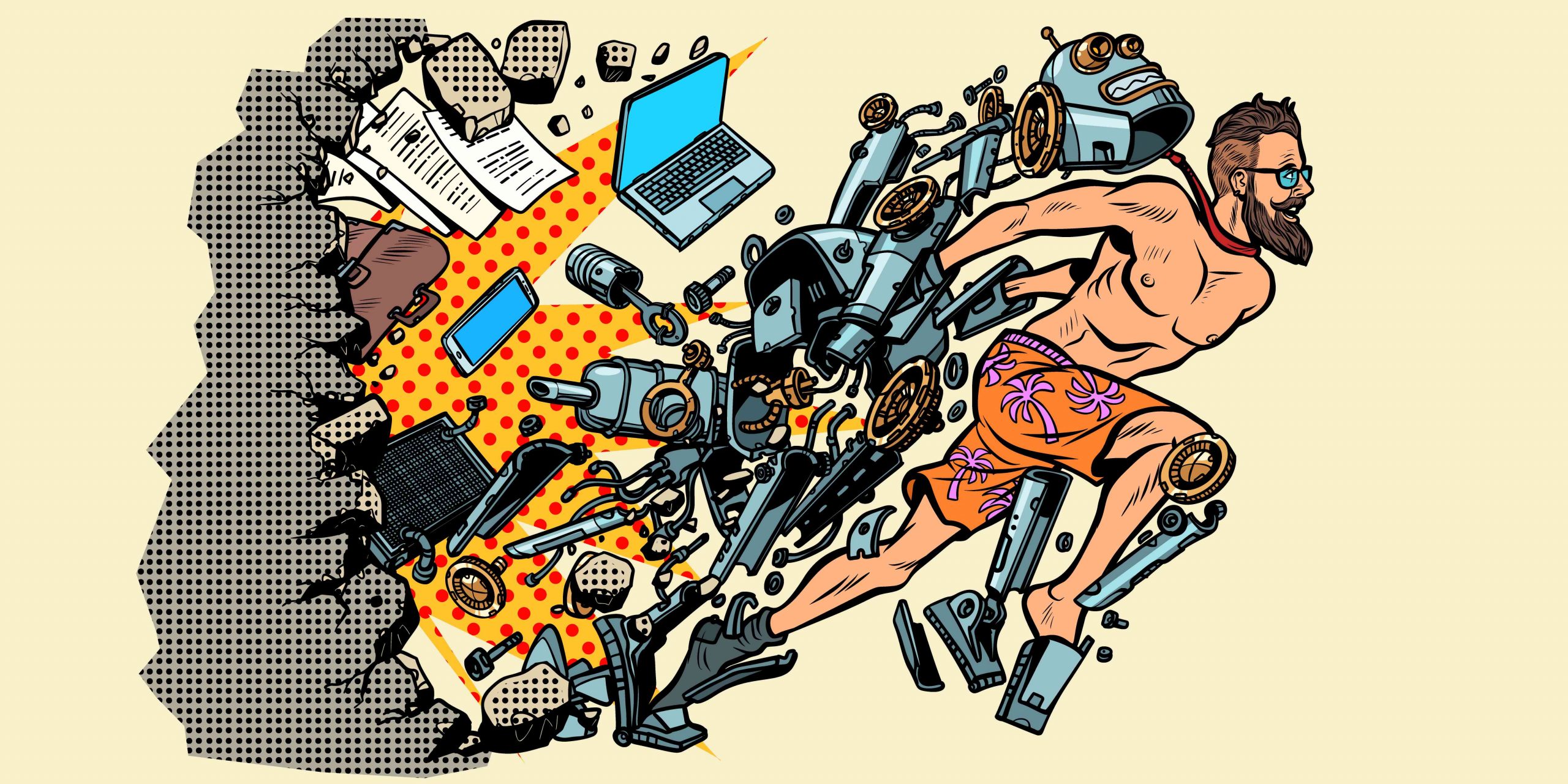It’s been a crazy year in tech:
• Artificial intelligence infiltrated everything.
• Elon Musk and Mark Zuckerbergagreed to a cage fight (which never happened).
• High-schoolers made pornographic clones of their classmates.
• A high-profile tech CEO was fired and rehired over a weekend.
• Oh, and Apple unveiled its least-mainstream product since the G4 Cube.
We could go on, but we’re here to look forward. That’s the best part about this annual exercise, where we all pile into an electric time-travel vehicle and set the Google Maps destination to The Future.
So what can we predict for 2024? AI as far as the…A-eye can see. We won’t even pretend to know all the things generative AI will do to our devices, our jobs, our lives—and our elections. But we promise you won’t be able to escape it. We’ll see other things too: the decline of the dreaded password, a boom in cleaner energy, increasing regulation around kids on social media, and more.
And yes, Apple will start selling a $3,500 face computer that aims to change how we see the world, or at least our living rooms.
Here are our predictions for the coming year in tech.
Is it real?
When photos of a bull walking on train tracks in New Jersey recently went viral, many people’s first thought was, “Did AI make this?” No, the photo was the real deal. (Don’t worry, the bull is safe now.)
This is the internet challenge of 2024: How do we tell the real from the AI? The generative-AI product flood will continue, but also expect more tools to help us pinpoint artificially generated text, photos, video and audio.
OpenAI, specifically, has promised a feature that will identify whether an image is created by its Dall-E 3 image generator. TikTok has said it is working on ways to detect and automatically label AI-generated content.
The Adobe-led Content Authenticity Initiative, which provides technology to embed information about the origin of an image or video into the file, will also continue to gain steam. Microsoft has said it will launch a tool for political candidates and campaigns that allows them to add credentials to media so people will know how it was created or edited. Camera maker Leica recently announced a new camera that automatically embeds such credentials in its photos.
At some point, we might just regard content without credentials as suspicious.
EVs struggle to accelerate
If you’re expecting 2024 to be the Year of the EV Boom, think again. “It’s not that EV sales are down, it’s that the pace of growth is slowing down,” said Barclays analyst Dan Levy.
That deceleration looks to continue but it marks a turning point: More mainstream car buyers are now catching their breath and beginning to assess their EV options. Two of the biggest consumer pain points—price and charging—will start to improve. Especially for people looking beyond Tesla.
Sometime in 2024, Ford, General Motors, Rivian and others will be able to charge at many of Tesla’s charging sites. That should significantly increase the number of places EV drivers can stop to charge on a long road trip. Additionally, we’ll see the launch of more fast-charging stations funded through the Biden administration’s National Electric Vehicle Infrastructure program. Here’s hoping they work—and actually accept credit cards.
Starting Jan. 1, if you’re buying an EV that’s eligible for a federal tax credit you can get that discount at the point of sale. You will no longer have to wait until you file your taxes. The bad news: Fewer EVs will qualify for the credit. But at least there are some sub-$40,000 EVs on the way, including the Chevy Equinox EV and Volvo EX30.
The clean-tech boom begins
Electric vehicles may seem like the embodiment of so-called “clean tech”—driven in no small part by a certain eccentric billionaire and his car company. But the EV supply chain is enabling hardware companies of all kinds to make use of really big batteries, and the critical “power electronics” that go with them.
For example, in Vermont, the biggest regional utility is turning batteries into a distributed energy-storage network it calls a “virtual power plant.” In-home batteries can recharge from the grid when energy is plentiful, and put it back into the grid when demand shoots up or there are outages, increasing reliability and saving customers money. Even electric vehicles can help in a similar way: Ford says its electric F-150 can power your home in a blackout.
And the relentless rollout of new sources of low-carbon and renewable energy is proceeding apace, including offshore wind, rooftop solar and geothermal power from the earth’s own heat. Startups—backed by big money—are looking to develop a generation of smaller, safer modular nuclear reactors, too.
AI + PC = ?
In 2024, every major manufacturer is aiming to give you access to AI on your devices, quickly and easily, even when they’re not connected to the internet, which current technology requires. Welcome to the age of the AI PC. (And, yes, the AI Mac.)
What’s coming is what engineers call “on-device AI.” Like our smartphones, our laptops will gain the ability to do the specialized computing required to perform AI-boosted tasks without connecting to the cloud. They will be able to understand our speech, search and summarize information, even generate images and text, all without the slow and costly round trip to a tech company’s server.
On Dec. 14, Intel announced its entrants into this race, chips with built-in neural-processing units. Qualcomm announced similar chips in late October. Both silicon giants will compete to power Windows laptops and Chromebooks. Look for more announcements of chips to enable on-device AI, possibly from Nvidia and AMD. Apple—which brought variations of its neural-engine-equipped mobile chips to laptops and desktops in 2020—will be making that specialized processing power available to software developers in new ways.
The hardware will show up before the compelling software applications do, but we’ve already seen some promising demos—like fast AI-powered photo-editing tools.
Longer life for older gadgets
Unlike milk and bread, there’s no expiration date printed on our gadgets’ packaging. That doesn’t mean they don’t have them. Modern, internet-connected devices remain tied to their makers after we buy them. And when the makers stop providing services and software updates, they die.
A growing number of manufacturers and brands are extending software support, however. Apple—which updates iPhones for about six years, and Macs for six to eight years depending on the model—was the gold standard, but it has fallen a bit behind Alphabet’s Google. For its new Pixel 8 phones, Google upped support to seven years. The company also said it will provide updates to Chromebooks for up to a decade starting in 2024.
Samsung previously updated phones for just two years, with four years of security patches. It recently committed to four years of system updates, with an additional year of security. Microsoft announced earlier this month that after support for Windows 10 machines ends in 2025, customers can continue receiving security updates for a fee.
By stretching devices’ lifespans, companies could reduce some of the 6.9 million tons of electronics waste we generate annually, according to nonprofit public-interest group U.S. PIRG.
Apple’s mixed reality meets the real world
Will Apple’s Vision Pro change the way we work by putting floating 3-D spreadsheets on our office walls? Will it make us all yearn to FaceTime with holo-grandma? Will it finally make 3-D movies cool? Or, at $3,499, will it be the world’s most expensive paperweight? We find out in early 2024.
In early trials, we’ve been impressed with just how natural it is to navigate the digital interface with just hand waves and finger taps. It still is quite a substantial piece of hardware you have to put on your head, however, battery pack and all.
Given its price tag and its first-generation status, the Vision Pro isn’t positioned to be a mainstream hit. Instead, Apple’s betting on early adopters and software developers to define the killer apps of spatial computing—the idea that we can blend our real lives and digital worlds in new ways. As Apple Chief Executive Tim Cook said during the Vision Pro’s introduction, it’s “the beginning of a journey.”
Cracks in Apple’s garden walls
Perhaps the president of the European Commission should just move her office to Cupertino, Calif. In 2023, EU legislation forced Apple to give up its proprietary Lightning port in favor of USB-C on the iPhone 15. Next year, EU regulation will push Apple to make additional changes.
While Apple’s App Store has been the only way to install apps on the iPhone, the EU’s Digital Markets Act aims to change that. It requires the “gatekeepers”—specific tech companies—to stop restricting users from getting apps from outside its own app stores. The deadline to comply is March 7. A recent Securities and Exchange Commission filing from Apple stated that the company “expects to make further business changes in the future” to the App Store. (Google’s Android already allows users to install apps downloaded from outside its Google Play app store.)
It’s unclear if Apple would change the App Store only in the EU or around the globe. An Apple spokesperson declined to comment on the company’s plans.
Then there’s Apple’s tightly protected iMessage. Beeper, a new app that brings iMessage to Android devices, has regulators pressuring the giant to open up its exclusive iMessage chat platform. Separately, Apple has agreed to adopt RCS, a messaging standard that will make “green bubble” texting with Android phones a bit more like iMessage.
Passkeys in more places
Passwords are lousy. When hackers exposed information belonging to around 6.9 million customers of DNA test-kit company 23andMe, the company said the attackers tried credentials stolen from other websites. Because people often reuse their usernames and passwords, thousands of logins worked.
That’s why, in 2023, companies including Google, Apple and Amazon moved toward passkeys, a type of login that can replace passwords and two-factor authentication codes. Starting next year, Microsoft will roll out passkeys for businesses.
A passkey is more secure than a traditional login because each is unique, it won’t work on fake sites designed to trick us and it can’t be stolen from company servers. It’s stored inside password managers and can be accessed with a face or fingerprint scan.
Today, over eight billion accounts are passkey-enabled, according to Andrew Shikiar, executive director of FIDO Alliance, which oversees security standards for passkeys. Shikiar expects 20 billion passkey-capable accounts by the end of 2024.
Rocking the vote in 2024
Millions can now generate images and videos with AI—and potentially influence elections around the world. In 2024, an estimated two billion people will vote in 50 countries. While manipulated media isn’t new, the ability to create convincing AI-generated sounds and imagery on a dime is. The White House said generative-AI systems have the potential to “erode public trust and safety in democracy.”
Former President Donald Trump posted a parody of Republican Ron DeSantis’s campaign launch with a video featuring AI-generated voice clones. In turn, a pro-DeSantis super PAC ran a television ad attacking Trump, using an AI-generated version of his voice. Meta Platforms is requiring advertisers to disclose when political ads on its Facebook and Instagram contain digitally altered media.
AI-enabled content isn’t the only concern. We can expect just as much or more old-fashioned disinformation compared with the last presidential election, too, said Erik Nisbet, a professor of communication at Northwestern University. That’s because some social-media platforms have either changed their policies or pared back their content-moderation efforts, Nisbet said.
Research has shown a particular rise in malign content on X, he added. The company didn’t respond to a request for comment. Meta now allows ads to say past elections were “rigged” or “stolen,” a false claim often repeated by Trump. At a conference, Meta’s head of global affairs said private-sector companies shouldn’t arbitrate whether politicians can “make claims or counterclaims about the legitimacy of previous elections.” Google’s YouTube will also no longer remove content questioning the legitimacy of former elections, saying the action could “have the unintended effect of curtailing political speech.”
Ride in a self-driving car—no, really
Robotaxis and self-driving vehicles in general had a rough 2023. GM subsidiary Cruise lost its license to operate in California and subsequently laid off about a quarter of its workforce. Tesla faced lawsuits over its “full self-driving system” on account of its apparent reliance on human monitoring, despite the marketing. And residents of San Francisco, the self-driving-est city in the U.S., expressed doubts about this technology.
Yet amid the chaos, there have been winners—in particular Alphabet subsidiary Waymo, which is continuing to expand its robotaxi service to more cities. If you travel to Phoenix, San Francisco, Los Angeles or Austin, Texas, you can hop in one of the company’s driverless taxis today. And it’s…surprisingly normal?
Meanwhile, Mercedes-Benz gained approval to roll out the first hands-free, eyes-off-the-road autonomous driving system in the U.S. It only works on certain roads, under certain conditions. Jeep and Chrysler parent Stellantis is working on a version, which it says will arrive in 2024. Ford says it will have its version in 2025.
No surprise, then, that in Phoenix, you can now hail a Waymo robotaxi through Uber, thanks to a recently announced partnership. Yes, the future is here. You just might have to go to Phoenix to find it.
Another social-media reckoning
As they seem to every year, Meta and TikTok face massive lawsuits, new laws, curbs from regulators, and the possibility of huge fines.
In 2024, Meta will have to contend with a grab bag of suits from more than 40 state attorneys general trying to force the company to change features of its products that the AGs allege harm minors. These include features that attempt to maximize teens’ and adolescents’ time spent on Meta subsidiary Instagram.
The company said: “We share the attorneys general’s commitment to providing teens with safe, positive experiences online, and have already introduced over 30 tools to support teens and their families.”
In December, the New Mexico attorney general filed a suit alleging the company steers predators to the accounts of children on Instagram. In a statement, Meta said it uses technology, industry protocols and partners in law enforcement, including state attorneys general, “to help root out predators.”
Should the suits somehow force Meta to make its products less appealing, they may accelerate users’ flight to TikTok. That could reignite the long-smoldering fire in Congress to ban the TikTok app outright. The initiative has won bipartisan support, but not enough to make it law. States have attempted their own remedies, but in November a federal judge blocked Montana’s TikTok ban, signaling that such state-level laws are unlikely to stand.
Meanwhile, age verification sounded like a promising move to protect kids on social media. But doing it effectively means clearing some high technical and administrative hurdles. It’s not likely you’ll see that in 2024.
Beyond heartbeats and nighttime Zs
Wearable gadgets have long tracked heart rate and sleep. Soon, they’ll be out for blood.
The Wall Street Journal previously reported that Apple is studying a way to track blood pressure through sensors in the Apple Watch. Next year—when Apple is expected to commemorate the watch’s 10th anniversary with a new design—the company might finally release the feature, which can notify a watch wearer when blood pressure is trending upward and direct the user to verify the measurement with a traditional inflatable cuff, according to a report in Bloomberg.
Other wearables may not be far behind. Fitbit filed a patent application for a display that could estimate blood pressure when pressed. Samsung has offered blood-pressure measurement on its Galaxy Watches for several years, though the feature isn’t available in the U.S. for regulatory reasons. Aktiia is a wrist-based wearable with an optical sensor that can capture 24/7 blood-pressure data. It’s currently only available in Europe, and is awaiting authorization from the Food and Drug Administration for commercial availability in the U.S. Omron has a larger wearable device available in the U.S. now.
There’s certainly a market for this metric. The devices could make it easier to manage high blood pressure (aka hypertension), which affects as many as 119 million American adults, according to the Centers for Disease Control and Prevention.
—For more WSJ Technology analysis, reviews, advice and headlines, sign up for our weekly newsletter.
Write to Joanna Stern at joanna.stern@wsj.com, Nicole Nguyen at nicole.nguyen@wsj.com and Christopher Mims at christopher.mims@wsj.com



